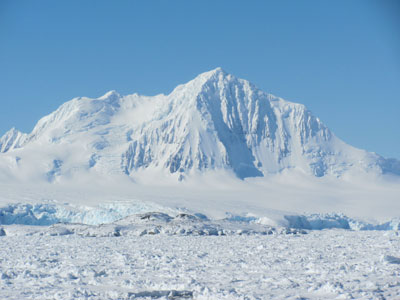The Southern Ocean Reveals Its Climate Secrets:
Paleotemperatures From Antarctic Margin Marine Sediments
By:
Amelia Shevenell
University of South Florida
Join us for coffee beginning at 10:00 a.m.
Click for a Live Broadcast.

Abstract
The disintegration of ice shelves, reduced sea-ice and glacier extent, and shifting ecological zones observed around Antarctica highlight the impact of recent atmospheric and oceanic warming on the cryosphere. Observations and models suggest that oceanic and atmospheric temperature variations at Antarctica's margins affect global cryosphere stability, ocean circulation, sea levels and carbon cycling.
In particular, recent climate changes on the Antarctic Peninsula have been dramatic, yet the Holocene climate variability of this region is largely unknown, limiting our ability to evaluate ongoing changes within the context of historical variability and underlying forcing mechanisms.
Knowledge of Antarctica's cryosphere evolution over the last 65 million years is derived from far-field deep-sea sediment records. Yet detailed studies of Antarctic margin sediments required to evaluate observed changes in the context of historic variability are lacking. Recent advances in drilling technology and geochemical climate proxies now make it possible to retrieve, date, and interpret high-quality ice-proximal sediment sequences from Antarctica's margins. These sequences, often devoid of calcium carbonate, contain information about the individual histories of the East and West Antarctic Ice Sheets and Southern Ocean temperatures.
We present a TEX86-based ocean temperature reconstruction from ODP Site 1098 (64°51'S, 64°12'W; 1010 meters water depth), which reveals a 3-4°C cooling near the western Antarctic Peninsula from 12 to 2 ka. Similar Holocene cooling is identified in Antarctic ice cores, Southern Ocean sediments, and model runs, highlighting the importance of local (65°S) spring insolation on Antarctic summer duration, ocean temperatures, and sea ice extent. On millennial timescales, TEX86-based ocean temperature reconstructions correspond with local/regional terrestrial temperature, westerly wind, and El Niño/Southern Oscillation variability, indicating that climate teleconnections between the tropical Pacific Ocean and the western Antarctic Peninsula strengthened late in the Holocene.
We conclude that during the Holocene, Southern Ocean temperatures at the western Antarctic Peninsula margin were tied to changes in the position of the Westerlies, which have a critical role in global carbon cycling. The Antarctic margin is Paleoceanography's final frontier. It is where we can best test hypotheses that oceanic and/or atmospheric temperatures at Antarctica's margins affected past cryosphere stability, global ocean circulation, sea levels and carbon cycling.




